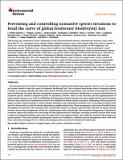Por favor, use este identificador para citar o enlazar a este item:
http://hdl.handle.net/10261/345829COMPARTIR / EXPORTAR:
 SHARE
BASE SHARE
BASE
|
|
| Visualizar otros formatos: MARC | Dublin Core | RDF | ORE | MODS | METS | DIDL | DATACITE | |

| Título: | Preventing and controlling nonnative species invasions to bend the curve of global freshwater biodiversity loss |
Autor: | Britton, J. Robert; Lynch, Abigail J.; Bardal, Helge; Bradbeer, Stephanie J.; Coetzee, Julie A.; Coughlan, Neil E.; Dalu, Tatenda; Tricarico, Elena; Gallardo, Belinda CSIC ORCID CVN ; Lintermans, Mark; Lucy, Frances; Liu, Chunlong; Olden, Julian D.; Raghavan, Rajeev; Pritchard, Eleri G. | Fecha de publicación: | jun-2023 | Editor: | Canadian Science Publishing | Citación: | Environmental Reviews 31(2): 310-326 (2023) | Resumen: | The Emergency Recovery Plan for freshwater biodiversity recognizes that addressing nonnative species is one of six principal actions needed to bend the curve in freshwater biodiversity loss. This is because introduction rates of nonnative species continue to accelerate globally and where these species develop invasive populations, they can have severe impacts on freshwater biodiversity. The most effective management measure to protect freshwater biodiversity is to prevent introductions of nonnative species. Should a nonnative species be introduced, however, then its early detection and the implementation of rapid reaction measures can avoid it establishing and dispersing. If these measures are unsuccessful and the species becomes invasive, then control and containment measures can minimize its further spread and impact. Minimizing further spread and impact includes control methods to reduce invader abundance and containment methods such as screening of invaded sites and strict biosecurity to avoid the invader dispersing to neighbouring basins. These management actions have benefitted from developments in invasion risk assessment that can prioritize species according to their invasion risk and, for species already invasive, ensure that management actions are commensurate with assessed risk. The successful management of freshwater nonnative species still requires the overcoming of some implementation challenges, including nonnative species often being a symptom of degraded habitats rather than the main driver of ecological change, and eradication methods often being nonspecies specific. Given the multiple anthropogenic stressors in freshwaters, nonnative species management must work with other restoration strategies if it is to deliver the Emergency Recovery Plan for freshwater biodiversity. | Descripción: | © 2023 Copyright remains with the author(s) or their institution(s). This work is licensed under a Creative Commons Attribution 4.0 International License (CC BY 4.0), which permits unrestricted use, distribution, and reproduction in any medium, provided the original author(s) and source are credited. | Versión del editor: | https://doi.org/10.1139/er-2022-0103 | URI: | http://hdl.handle.net/10261/345829 | DOI: | 10.1139/er-2022-0103 | ISSN: | 1181-8700 | E-ISSN: | 1208-6053 |
| Aparece en las colecciones: | (IPE) Artículos |
Ficheros en este ítem:
| Fichero | Descripción | Tamaño | Formato | |
|---|---|---|---|---|
| Preventing_ER_2023_OA.pdf | 641,88 kB | Adobe PDF |  Visualizar/Abrir |
CORE Recommender
Page view(s)
8
checked on 18-may-2024
Download(s)
2
checked on 18-may-2024
Google ScholarTM
Check
Altmetric
Altmetric
Este item está licenciado bajo una Licencia Creative Commons

